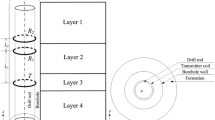Abstract
In this paper, responses of a new dual-induction resistivity logging-while-drilling (LWD) tool in 3D inhomogeneous formation models are simulated by the vector finite element method (VFEM), the influences of the borehole, invaded zone, surrounding strata, and tool eccentricity are analyzed, and calibration loop parameters and calibration coefficients of the LWD tool are discussed. The results show that the tool has a greater depth of investigation than that of the existing electromagnetic propagation LWD tools and is more sensitive to azimuthal conductivity. Both deep and medium induction responses have linear relationships with the formation conductivity, considering optimal calibration loop parameters and calibration coefficients. Due to the different depths of investigation and resolution, deep induction and medium induction are affected differently by the formation model parameters, thereby having different correction factors. The simulation results can provide theoretical references for the research and interpretation of the dual-induction resistivity LWD tools.
Similar content being viewed by others
References
Anderson, B., Bonner, S., Luling, M. G., and Rosthal, R., 1992, Response of 2-MHz LWD resistivity and wireline induction tools in dip** bed sand laminated formations: J. Log Analyst, 33(5), 461–475.
Allan, V., Sinclair, P., Prain, K., and Page, S., 2004, Design, development and field introduction of a unique low-frequency (20 Khz) induction resistivity logging-while-drilling tool: SPWLA 45th Annual Logging Symposium, 1–14.
Dubcova, L., Solin, P., Cerveny, J., and Kus, P., 2010, Space and time adaptive two-mesh hp-finite element method for transient microwave heating problems: Electromagnetics, 30, 23–40.
Doll, H. G., 1949, Introduction to induction logging and application to logging of wells drilled with oil base mud: Journal of Petroleum Technology, 1(6), 148–162.
Feng, Q. N., Ju, X. D., Ke, S. Z., and Li, H. Y., 2010, Logging tool principle: China Petroleum Industry Press, Bei**g.
Hagiwara, T., Banning, E., Ostermeier, R., and Haugland, M., 2004, Effects of mandrel, borehole and invasion for tilt-coil antennas: 80th SPE Annual Technical Conference and Exhibition, SPE 84245, 1–11.
**, J. M., 2002, The finite element method in electromagnetics: Wiley-IEEE Press.
Lovell, J. R., 1993, Finite element methods in resistivity logging: Ph.D.Thesis, Delft University of Technology, Netherlands.
Meyer, W. H., Hart, E., and Jensen, K., 2008, Geosteering with a combination of extra deep and azimuthal resistivity tools: 84th SPE Annual Technical Conference and Exhibition, SPE 115675, 1–14.
Mahiout, S., 2012, High-resolution LWD resistivity images for carbonate facies identification and geosteering: 88th SPE Annual Technical Conference and Exhibition, SPE 162274, 1–20.
Matuszyk, P. J., and Torres-Verdin, C., 2011, HP-adaptive multi-physics finite-element simulation of wireline borehole sonic waveforms: 81th SEG Annual International Meeting, Expanded Abstracts, 444–448.
Pardo, D., Demkowicz, L., Torres-Verdin, C., and Paszynski, M., 2006, Two-dimensional high-accuracy simulation of resistivity logging-while-drilling (LWD) measurements using a self-adaptive goal-oriented hp-finite element method: SIAM Journal on Applied Mathematics, 66(6), 2085–2106.
Sun, X. Y., Nie, Z. P., Zhao, Y. W., Li, A. Y., and Luo, X., 2008, The electromagnetic modeling of logging-while-drilling tool in tilted anisotropic formations using vector finite element method: Chinese J. Geophysics (in Chinese), 51(5), 1600–1607.
Shen J. S., Sun W. B., Zhao W. J., and Zeng W. C., 2008, Application of 2.5D cross-hole electromagnetic inversion in Gudao Oil Field, East China: Applied Geophysics, 5(3), 159–169.
Solin, P., Dubcova, L., Cerveny, J., and Dolezel, I., 2010, Adaptive hp-FEM with arbitrary-level hanging nodes for Maxwell’s equations: Advances in Applied Mathematics and Mechanics, 2(4), 518–532.
Wei, B. J., 2007, Response and calibration of a new logging-while-drilling resistivity tool: Chinese J. Geophysics (in Chinese), 50(2), 632–641.
Wang, H., Tao, G., Zhang, K., and Li, J., 2012, Numerical simulation for acoustic reflection imaging with FDM and FEM: 74th EAGE Technical Program Expanded Abstracts, 1–5.
Yuan, S. Y., and Wang, S. X., 2013, Edge-preserving noise reduction based on Bayesian inversion with directional difference constraints: Journal of Geophysics and Engineering, 10(2), 1–10.
Zhou, Q., and Hilliker, D. J., 1991, MWD resistivity tool response in a layered medium: Geophysics, 56(11), 1738–1748.
Author information
Authors and Affiliations
Corresponding author
Additional information
The research is supported by the National Oil and Gas Major Projects (No. 2011ZX05020-002).
Xu Wei is a PhD student at the China University of Petroleum, Bei**g. He received his B.E. in Exploration Technology and Engineering (2010) from Yangtze University and his M.E. in Earth Exploration and Information Technology (2013) from China University of Petroleum, Bei**g. His research mainly focuses on principles and applications of resistivity logging while drilling.
Rights and permissions
About this article
Cite this article
Xu, W., Ke, SZ., Li, AZ. et al. Response simulation and theoretical calibration of a dual-induction resistivity LWD tool. Appl. Geophys. 11, 31–40 (2014). https://doi.org/10.1007/s11770-014-0417-5
Received:
Revised:
Published:
Issue Date:
DOI: https://doi.org/10.1007/s11770-014-0417-5




